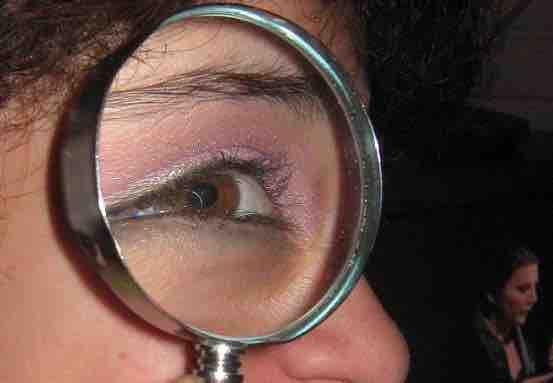Look Inward to Uncover Blinders
A public speaker should turn her mental magnifying glass inward to examine the values, beliefs, attitudes, and biases that may influence her perception of others. The speaker should use this mental picture to look at the audience and view the world from the audience's perspective. By looking at the audience, the speaker understands their reality.

Magnifying Glass
Speakers should use a metaphorical magnifying glass to examine their values, beliefs, and attitudes.
When the speaker views the audience only through her mental perception, she is likely to engage in egocentrism. Egocentrism is characterized by the preoccupation with one's own internal world. Egocentrics regard themselves and their own opinions or interests as being the most important or valid. Egocentric people are unable to fully understand or cope with other people's opinions and a reality that is different from what they are ready to accept.
Understanding Audience Background, Attitudes, and Beliefs
Public speakers must look at who their audience is, their background, attitudes, and beliefs. The speaker should attempt to reach the most accurate and effective analysis of her audience within a reasonable amount of time. For example, speakers can assess the demographics of her audience. Demographics are detailed accounts of human population characteristics and usually rendered as statistical population segments.
For an analysis of audience demographics for a speech, focus on the same characteristics studied in sociology. Audiences and populations comprise groups of people represented by different age groups that:
- Are of the same or mixed genders
- Have experienced the same events
- Have the same or different sexual orientation
- Have different educational attainment
- Participate in different religions
- Represent different cultures, ethnicities, or races
Speakers assess the audience's attitude - a positive or negative evaluation of people, objects, event, activities, or ideas - toward a specific topic or purpose. The attitudes of the audience may vary from extremely negative to extremely positive, or completely ambivalent. By examining the preexisting beliefs of the audience regarding the speech's general topic or particular purpose, speakers have the ability to persuade the audience members to buy into the speaker's argument. This can also help with speech preparation.
Tips for the Speaker
The depth of the audience analysis depends of the size of the intended audience and method of delivery. Speakers use different methods to become familiar with the background, attitudes, and beliefs of audiences in different environments and using various mediums (e.g., videoconferencing, phone, etc). For a small audience, the speaker can simply speak with them in a physical environment. However, the speaker is addressing a larger audience or speaking via teleconferencing or webcasting tools, it may be useful to collect data via surveys or questionnaires.